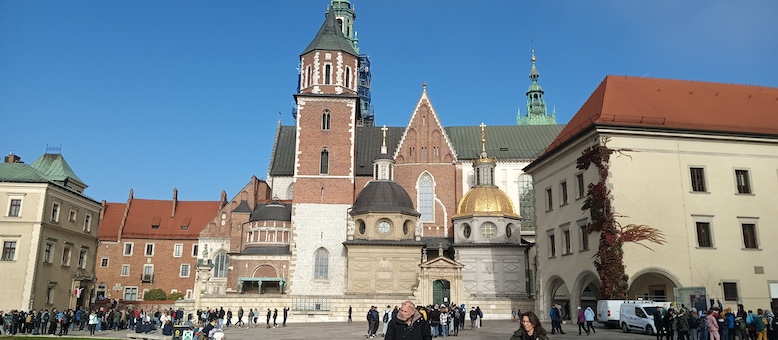
Wawel Cathedral where Polish Kings were crowned for centuries. Photo by Sharon McDonnell
By Sharon McDonnell
The Polish city of Krakow is full of marvels, from its gorgeously preserved Old Town with Europe’s biggest medieval market square and a castle where the Kings of Poland lived for centuries, to the factory of Schindler’s List fame. But Poland’s second-biggest city also houses priceless art treasures by Leonardo da Vinci plus an astounding underground chapel with countless sculptures of humans and animals, all carved from salt. Krakow’s historic Old Town, Wawel Castle and the royal salt mines were named to the first-ever UNESCO World Heritage Site list in 1978.
Krakow was the center of the Nazi government in Poland during World War II, led by Hans Frank, its Governor-General starting in 1939 when Hitler’s invasion of Poland near Gdansk kicked off the war, but it wasn’t destroyed during World War II, unlike Warsaw and Gdansk. “Nicknamed the Butcher of Poland, Hans Frank is said to have considered Krakow his jewel box, and so it survived the war,” says Cynthia L. Haven, the keynote speaker at Krakow’s 2024 Milosz literary festival, and a Stanford University humanities scholar. “Warsaw was a strategic target, the nation’s capital and it was razed to the ground to punish and undermine Polish resistance,” adds Haven, the manager of Stanford’s book club, Another Look, and author of Czeslaw Milosz: A California Life, a biography of Poland’s Nobel laureate poet. Milosz, a professor at the University of California, Berkeley who lived in Berkeley for almost 40 years, later moved to Krakow, a UNESCO City of Literature, and is entombed there.
“The Allies didn’t bomb Kraków primarily because it lacked significant military and industrial targets, unlike other cities that housed key war industries. The city’s rich cultural heritage also played a role, as destroying historic landmarks like Wawel and St. Mary’s Basilica would have been a tremendous loss,” says Andrzej Pawluszek, acting director, of the Polish National Tourist Office North America.
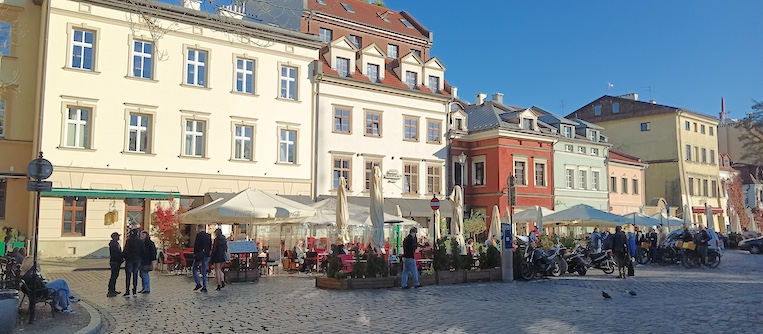
Sidewalk cafes line Rynek Glowny in Old Town Krakow. Photo by Sharon McDonnell
Market Square – And What Lies Beneath
Krakow’s market square, Rynek Glowny, over nine acres in size, was built in 1257 at the intersection of both east-west and north-south trade routes, from the Baltic to the Black Sea, and from England and Flanders to eastern Europe. The Old Town was laid out in a grid pattern around it. Lined with pastel-colored buildings, sidewalk cafes, restaurants and horses pulling delicate carriages that resemble what Cinderella took to the ball, it’s Krakow’s living room. I chose one of those restaurants, Szara Ges, for dinner: a wonderful duck in elderberry/red wine sauce, with cauliflower puree and white chocolate sauce.
Below the market square is a fascinating, high-tech archeology museum, Rynek Underground. You enter through the Cloth Hall, an arcaded Renaissance-style building with Gothic elements in the middle of the square, filled today with handicraft and amber jewelry shops, across from St. Mary’s Basilica, a Gothic church where a bugler appears every hour, a memorial to a bugler who once warned of an enemy attack, but died. During a renovation of Rynek Glowny’s eastern side, remains of the original 1,000-year-old market were found, so a thorough archeology dig was conducted during 2005-10, and the museum opened afterward. You see exhibits on trade routes to Krakow – whose wealth was built on salt, a valuable item for preserving food long before refrigeration and also for seasoning – and its importance in the Hanseatic League. Amber from the Baltic coast, copper and wine from Hungary, Ottoman rugs, wax from Lviv and silks were some products traded. You’ll also see exhibits on “vampire prevention burials” (skeletons decapitated or in fetal positions, so the dead wouldn’t return to haunt the living), medieval cosmetics and fashion. Relics of huts before the Mongols destroyed the original settlement in 1241, remains of 13th and 14th-century trade stalls, artifacts like an 11th-century pendant from Istanbul and a 12th-century coin from Armenia, and reconstructed goldsmith and blacksmith workshops are also here.
Wawel Castle: A Dragon, Kings And Ottoman Tents
Before I saw Wawel Castle, I knew Krakow’s origin story, thanks to a different local legend placed in my room each day at Balthazar Design Hotel, a beautiful boutique hotel a block from the castle on Grodzka Street. An eight-minute walk to Rynek Glowny, Grodzka is part of the Royal Route Kings traveled from the city gates to Wawel. Located on a hilltop overlooking the city, Grodzka is lined with shops, restaurants and churches today.
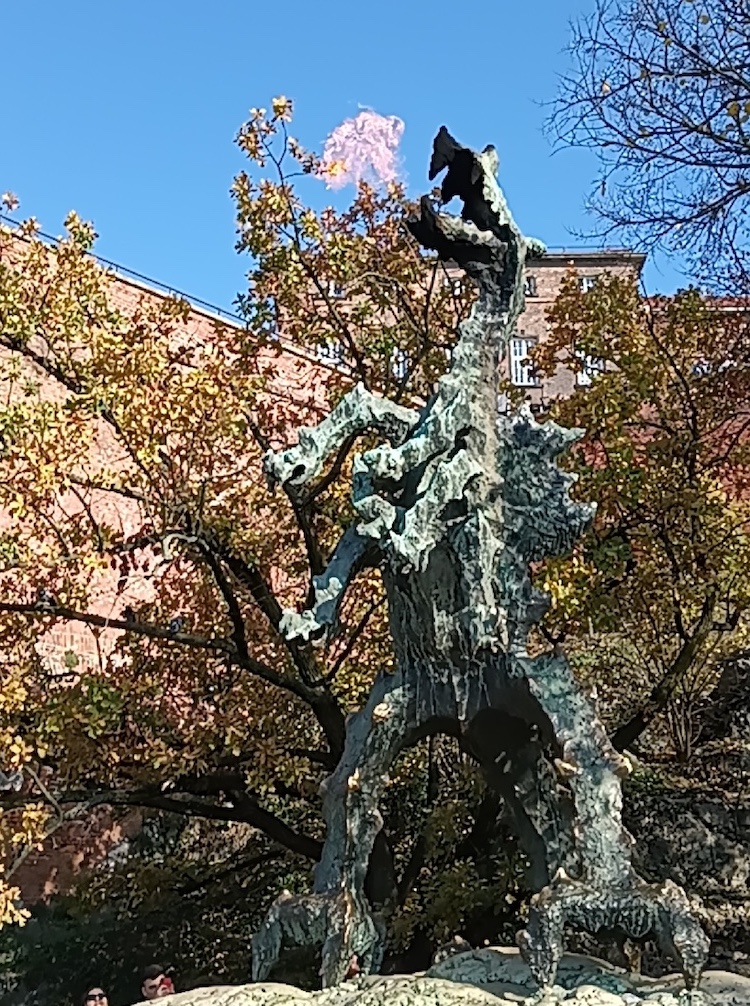
Wawel Castle Dragon Sculpture Krakow is named after a cobbler named Krak who killed the dragon. Photo by Sharon McDonnell
A dragon who lived in the caves below the castle kept abducting young women and killing villagers, so the King promised his daughter’s hand in marriage to anyone who could kill the beast, the legend says. A cobbler named Krak tricked the dragon into eating a sheep whose stomach was filled with sulfur. The dragon exploded, Krak wed the princess and became King, and Krakow was named to honor its dragon slayer. (Rynek Underground depicts the legend in a multimedia show.) Fittingly, a metal dragon statue, which stands in front of Wawel’s caves on the banks of the Vistula River, belches fire every five minutes.
Wawel Castle – the royal residence from the 11th century until 1598, when Warsaw became the capital of Poland – has over 1,000 oil paintings, many by Italian masters like Titian and Botticelli. One depicts the Battle of Lepanto in 1571, where the Turks were defeated by a coalition of Catholic countries. Over 100 Flemish tapestries of Biblical scenes and animals and walls of tooled leather with painted designs from Cordoba, Spain are also here. So are an unusual collection of Ottoman Empire tents, Europe’s biggest, captured in wars or purchased. Europe long feared attacks by the Turks, but a taste for exotic Ottoman tents and rugs became fashionable among Polish royalty and nobles, used in their homes and during travel. One colorful tent embellished with tulips, a beloved Turkish design motif, carnations and Arabic script is from the Turks’ resounding defeat in 1683 in Vienna, led by King Jan III Sobieski of Poland. Portraits of Polish royals clad in Ottoman-style dress, swords at their sides, are also here.
From Da Vinci to Winged Warriors
Da Vinci’s portrait of the young mistress of the Duke of Milan cuddling a small furry white animal, Lady With An Ermine, is in the Czartoryski Museum in the Old Town, located by the Florian Gate and Tower, the last of 48 towers that once encircled the Old Town. The museum displays the vast and eclectic collection of the noble Czartoryski family. But the da Vinci masterpiece, stolen by the Nazis (Hans Frank hung it on the wall of his office at Wawel Castle) but returned after the war, is just one of its many treasures.
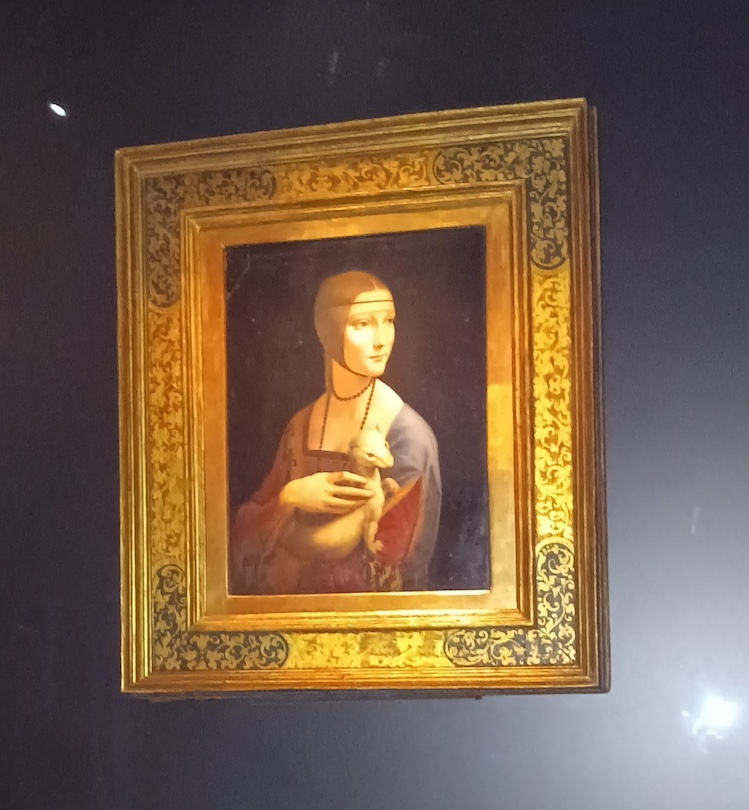
Lady With An Ermine by Leonardo da Vinci. Photo by Sharon McDonnell
Egyptian and Etruscan sarcophagi, Dutch Old Masters paintings, odd winged armor adorned with bird feathers worn by Polish hussar knights, the most feared cavalry in 17th century Europe, ornate brocaded horse saddles and bridles, a peacock tasting cup made from a Nautilus shell covered in silver and swords from the Battle of Grunwald in 1410 (when the Polish-Lithuanian Commonwealth defeated the Teutonic Knights, marking this union of the Kingdom of Poland and the Grand Duchy of Lithuania as a major political force at that time). The museum is across from Jama Michalika, a famous artists’ café on Florianska Street, a major shopping street. Established in 1895, it’s known for its Art Nouveau stained glass panels, woodwork and murals.
Schindler’s List
Across the Vistula River from Old Town is the Schindler Enamel Factory in Podgorze, an industrial district, whose German owner, Oskar Schindler, saved the lives of about 1,200 Jews in WWII. Stories of the Nazi occupation of Krakow, whose 60,000 Jewish residents were forcibly moved in 1941 to Podgorze, are told in a film, photos, radio broadcasts and videos at the museum, as well as photos of many people Schindler rescued. Buried in Jerusalem after he died in 1974, Schindler, immortalized in Steven Spielberg’s movie Schindler’s List, is honored by Yad Vashem, Israel’s Holocaust History Museum, as the Righteous Among Nations.
An Empire Built on Salt
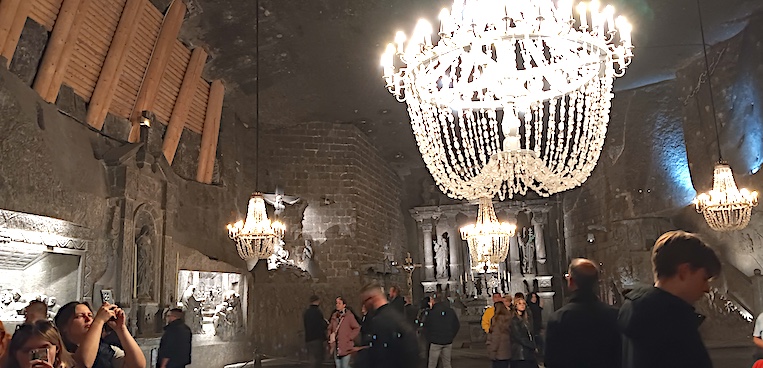
Wieliczka Salt Mine Chapel is illuminated by enormous chandeliers and decorated with religious iconography. Photo by Sharon McDonnell
South of Krakow almost nine miles away, the Wieliczka Salt Mine is an absolute jaw-dropper (and testament to human ingenuity). Considered the world’s oldest salt mine, the mine began in the 13th century, when underground salt deposits were discovered and operated until 1996. Nine levels descend over 1,000 feet below the ground, and on my guided tour I saw the first three levels, descending to about 400 feet. Hard rock salt surrounded me everywhere, on the walls, floors and ceilings of tunnels and over 2,000 carved chambers.
“Don’t lick the walls,” warned our guide, who said salt once made up one-one-third of Poland’s economy. A revelation to anyone who thinks salt always comes from the ocean, like me (I’d seen salt pans by the sea in Slovenia and Bonaire), the mine was once, millions of years ago, a salty sea that dried up. (Today, Krakow is almost 400 miles from the Baltic Sea.) Salt sculptures kept appearing, from a miner kneeling to present a lump of salt to the Queen of Poland, and gnomes to Copernicus, the Polish astronomer, who studied in Krakow.
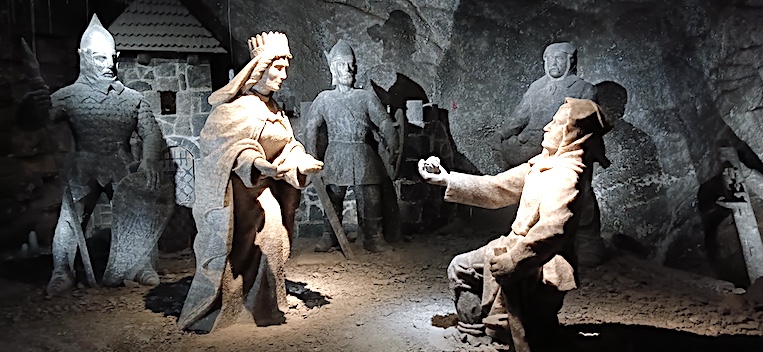
Deep in the Wieliczka Salt Mine one of the intricately carved statues shows a miner handing the Polish Queen a lump of salt. Photo by Sharon McDonnell
In the Chapel of St. Kinga, everything from the chandeliers, altar, and statues to bas-reliefs on the walls is carved from salt, except for the light bulbs. Mary and baby Jesus on a donkey with Joseph, surrounded by palm trees and low buildings, are the subjects of one wall carving. The Last Supper of Christ and his apostles is another. In 1689, the mines started to offer daily Catholic Mass for employees, so miners began to carve the underground chapel and statuary, notes Salt: A World History, a book by Mark Kurlansky about the importance of salt over the centuries, and how it shaped trade routes and cities and provoked wars in many countries. Workers carved salt in their free time, and later management paid them, after recognizing their talent. In the 17th century, the King invited guests to tour the mines, dance in its ballroom and row in its underground lakes, Kurlansky notes.
Concerts and weddings have been held inside the chapel, which has great acoustics, while corporate meetings and meals are served in other windowless salt chambers. A 100-foot-high chamber we stood in was a site for hot air balloon rides and bungee jumping, we heard. Thankfully, at the end of our tour, a small elevator whisked us to the top.![]()
Sharon McDonnell is a travel, culture, food and drink writer in San Francisco. Her previous story for EWNS is on Estonia.

